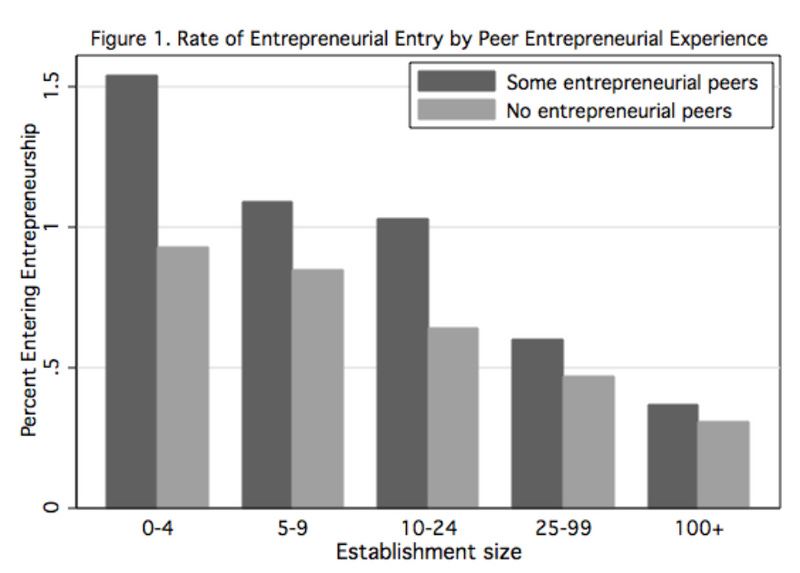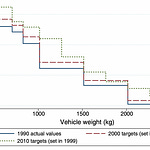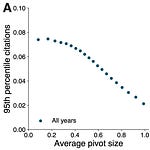Is entrepreneurship contagious? Consider a few cases:
Two different teams of scientists make substantially the same discovery at roughly the same time. One of the teams goes on to found a startup based on the idea; the other does not. Why?
Marx and Hsu (2021) study basically this situation. They identify ~20,000 such “twin” discoveries by finding cases where two papers by two different teams are published within a year of each other, share a large portion of subsequent citations, and are cited at least one time in the same parenthetical block, (for example, “(Clancy 2021, Marx and Hsu 2021)”), which is an indication each of the papers can be cited without elaboration to justify the same claim. They go on to identify a couple hundred cases where these discoveries are subsequently commercialized via a startup and look to see what factors are correlated with a decision to commercialize the discovery.
One such factor is if one of the scientists who made the discovery has a history of commercialization - no surprise there. Scientists who have commercialized their research before are probably more likely to do it again. But more intriguing, they also find that if one of the scientists making the discovery has previously collaborated with a scientist with a history of commercialization, the discovery is more likely to be commercialized, even if the discovering scientist does not have a history of commercialization themselves. It’s as if the entrepreneurship bug jumped from one coauthor to another.
We can broaden this line of inquiry to workplaces in general with Nanda and Sørensen (2010). Nanda and Sørensen track approximately 270,000 workers in Denmark over the period 1990-1997, each of whom has no prior history of entrepreneurship before 1990, and were newly hired by an established employer in 1990. For each of these individuals, they count how many of the individual’s co-workers were entrepreneurs during the previous five years (and for how long). They then see how the presence of formerly entrepreneurial coworkers affects the subsequent decision of an individual to start a business.
Again, people whose coworkers have a history of entrepreneurship are more likely to go on to be entrepreneurs themselves. One weakness of this data is that Nanda and Sørensen only know if people worked at the same establishment; they don’t know if the coworkers ever had any actual interaction. But it’s a reasonable guess that people were more likely to interact with their coworkers when they both worked at small establishments. And as the figure below indicates, the impact of entrepreneurial peers is greatest in the settings where the probability of an interaction is highest.
We can broaden this to whole communities as well. Giannetti and Simonov (2009) look at how the rate of entrepreneurship in an individual’s local neighborhood affects their decision to become an entrepreneur. Using a sample of 289 Swedish municipalities, Giannetti and Simonov show residents are more likely to become new entrepreneurs (this year) when there were more existing entrepreneurs in the neighborhood (last year). This is also true for people who did not grow up in the neighborhood, but only moved there later in life.
As with Nanda and Sørensen, a weakness in this data is that we only know where people live; we don’t actually know if people residing in the same neighborhoods interact with each other (though Giannetti and Simonov cite studies showing the bulk of interactions are, in fact highly local). But Giannetti and Simonov also make the plausible suggestion that it is more likely people interact with neighbors who have a similar educational background. If that’s so, then if entrepreneurship “spreads” through social contact, the extent of entrepreneurship among residents of the local community who have the same educational background as an individual should predict whether that person subsequently becomes an entrepreneur. The extent of entrepreneurship among locals with a different educational background shouldn’t. And indeed, when Giannetti and Simonov partition their measure of local entrepreneurship into “same education background” and “different education background” categories, only the former is associated with someone becoming a new entrepreneur.
In all three cases - scientists, workplaces, local communities - did people catch the entrepreneurship bug from their peers?
Do entrepreneurs find each other or create each other?
The big challenge in this literature is establishing that this association is causal; that interacting with entrepreneurs makes people more likely to become entrepreneurs. It could, for example, be merely that aspiring entrepreneurs seek out actual entrepreneurs to be around. Maybe scientists who are interested in someday commercializing their research are drawn to work with serial entrepreneurs; some kinds of companies are appealing both to people aspiring to start a business and people who have started a business; and aspiring entrepreneurs move to places where entrepreneurship is common, in the same way aspiring actors move to Hollywood. In any of those situations, the correlation between “social exposure” to entrepreneurship and subsequent entrepreneurship could be spurious. It’s not that entrepreneurship is contagious, it’s merely that entrepreneurial types cluster.
This is not a problem these papers are unaware of. Marx and Hsu (2021) don’t present their results as causal. Nanda and Sørensen, and Giannetti and Simonov both try a bunch of different tricks to reduce the likelihood the results can be explained by merely by entrepreneurial types preferring to cluster together. To take one example, Nanda and Sørensen show their results hold even if you control for the number of entrepreneurs working at a company at the time an employee decided to work there (which might have influenced the decision to seek a job there) and instead focus just on new people who were hired after the focal individual started. They find the same result, but even so, you could imagine there is something about the workplace that is drawing entrepreneurial types to work there. But it is hard to do this in an airtight way.
One way to rule out the possibility that people predisposed to become entrepreneurs seek each other out is to look at settings where people form relationships without having any say in the matter. One such setting is family. Lindquist, Sol, and Van Praag (2015) study the career decisions of Swedish children born before 1970 to parents born after 1920. They find the children of entrepreneurs are about 12 percentage points more likely to be entrepreneurs at some point in their life than the children of non-entrepreneurs.
Obviously children can’t choose their parents. But with families, we also have to worry about a lot of other possible confounding factors. Specifically, with parents and children we might think this is all about genes. Perhaps the children of entrepreneurs merely inherit their parents’ taste for risk and autonomy, and it’s these shared preferences that lead both parents and their children to disproportionately choose to be entrepreneurs.
The cool thing about Lindquist, Sol, and Van Praag’s paper is that they have very good data on nearly 4,000 Swedish adoptees, which lets them parcel out the effects of genes (which derive from the birth parents) and the effects of being raised by an entrepreneur (which derive from the adoptive parents). Both matter. Adoptees with an entrepreneurial birth parent are about 4 percentage points more likely to be entrepreneurs at some point than those without. But children whose adoptive parent is an entrepreneur are about 8 percentage points more likely to become entrepreneurs themselves.
So genes seems to be part of it - maybe 1/3 - but the rest is coming from being raised by an entrepreneur. But that still doesn’t necessarily mean entrepreneurship is “contagious.” Maybe the children of entrepreneurs are more likely to become entrepreneurs simply because they have a family business to inherit or access to cheap loans from mom or dad. Lindquist, Sol, and Van Praag look a bit at all these options and try to rule them out in various ways (for example, they show inheriting the family business is quite rare and that the wealth of parents doesn’t affect the decision to be an entrepreneur, which suggests it’s not really about access to cheap loans). But we can also look at other papers where the social influence channel might matter, but things like inheritance or cheap loans don’t.
Eesley and Wang (2017) use an experiment to see what happens when people get close contact with an entrepreneur. One of the authors teaches a 10-week university class on innovation and entrepreneurship. As part of the class, students work in small teams with a pair of mentors from industry on a startup project. Randomly, some teams are matched with mentors who are entrepreneurs and others are matched with mentors who are not.
Eesley and Wang track these students for two years after graduating to see if they found or join a small startup. They then compare the rate at which students who were paired with entrepreneurs become entrepreneurs themselves with the control group of students paired with non-entrepreneurs. They find students who were randomly assigned an entrepreneur mentor founded or joined a startup 37% of the time, compared to 28% for those who were randomly assigned a non-entrepreneur mentor.
Are these numbers plausible? Compared to spending an entire childhood with a parent, in this case, the students spent on average just 5-7 hours in collaboration with their mentor. But it seems likely those collaborative hours meant a lot to the students; they self-assessed the mentoring portion of the class as one of the most important and they are part of a population who is curious about entrepreneurship (since they chose to take the class), working with a mentor on an industry they are also interested in.
OK, so those are two cases where people have no say in the decision to form a relationship with an entrepreneur. That’s rare in real life. But it is the case in real life that we may form associations with people for reasons that are quite incidental to their entrepreneurship. Let’s look at one of those studies next.
Azoulay, Stuart, and Liu (2017) look at elite academic life scientists, and study whether being mentored by a scientist who commercializes their research (by getting a patent) leads their postdocs to do the same. As you might expect, given the results from Marx and Hsu above, it does. But Azoulay, Stuart, and Liu’s paper is much more about trying to nail down the argument that this effect is not driven by entrepreneurial scientists seeking each other out.
To establish that students do not select postdoc mentors based on the commercial orientation of the advisor, Azoulay, Stuart, and Liu focus their study on academic life scientists who are selected to be Pew scholars or Searle scholars up through the year 2000. One reason to focus on this group is the existence of the Pew Scholar Oral History and Archives, a set of oral life histories available for 200 Pew scholars. The authors read a sample of 62 such histories (each is long; 100-400 pages) to see what kinds of factors Pew scholars self report as being important in their decision of which postdoc mentor to work with. The overwhelmingly most important factor cited was the scientific topic being investigated, followed by geography (where the lab was), the advisor’s prestige in the field, and interpersonal rapport. None mentioned the commercial orientation of the advisor, or their interest in patenting. And this wasn’t simply because they were shy to talk about non-academic goals; when asked about their own patents, interviewees were apparently quite candid.
Azoulay, Stuart, and Liu use this qualitative analysis to form the basis of some additional quantitative exercises. They come up with measures of scientific similarity, geographical proximity, and prestige, which they use to derive statistical models of the matching process between postdocs and mentors. They can then see if matches that are poorly explained by these stated factors seem to be unusually correlated with the decision to patent, which would be evidence that people left their true motivations - a desire to work with a scientist who patents - unstated. But they don’t really find any evidence of this. The statistics back up what the scholars say: recent graduates don’t really think about patenting when deciding who to work with for their postdocs. But if they “accidentally” end up working with an advisor with a history of patenting, they’re more likely to patent themselves, later in their career.
Not so fast
So far, that’s all pretty consistent with the thesis that entrepreneurship is contagious. Entrepreneurs are found in clusters, at least partially because entrepreneurs exert an influence over their otherwise non-entrepreneurial peers. You can see this when you randomly match students to entrepreneurs, when top scientists get incidentally matched with more entrepreneurial advisors, and when children get placed in the care of entrepreneurial parents. In all three cases, the exposed are more likely to become entrepreneurs themselves, than people who were not exposed.
But to close, let’s look at one more study, whose results muddy or challenge the above. Lerner and Malmendier (2013) exploit another natural experiment, where some groups are more exposed to entrepreneurs than others. In their case, they look at nearly 6,000 students who attended Harvard Business School over 1997-2004. At Harvard Business School, the administration breaks each incoming class into sections of 80-95 students. Students take all their classes with this cohort, and they typically form strong social bonds with other students in their section. Importantly, while the assignment of students to different sections is not random (the school endeavors to give each section a roughly representative cross section of various backgrounds), students have no say in the matter and their prior experience with entrepreneurship is not a factor considered by the school. That means there is some variation across sections; in some sections 0% of the students have a history of entrepreneurship and in others more than 10% of the students do.
Within each section, they then look to see what share of students who were not previously entrepreneurs, state their post-graduation plan is to found a company (or continue working on one they founded during school). In a simple model where entrepreneurship is contagious, we would expect to see more students opt to found companies if they were in a section where more of their peers were entrepreneurs in the past. In fact, the opposite is true!
In the figure below, each dot represents a section of students at Harvard Business School. The horizontal axis is the share of students in the section with prior experience as an entrepreneur. The vertical axis is the share of remaining students (those without prior entrepreneurship experience) who leave as entrepreneurs. The negative relationship is pretty clear.
What’s going on here? One obvious response might be that the kinds of entrepreneurs who quit their company and go to get an MBA are those who weren’t very successful. Maybe that dissuaded their peers?
But no. Actually, the kinds of entrepreneurs who get into Harvard Business School were pretty good at what they did. Significantly better than the population at large, frequently selling their companies for a large profit before going to get an MBA. Moreover, separating out exposure to “successful” entrepreneurs and “failed” entrepreneurs doesn’t really change the above results.
Lerner and Malmendier instead provide a variety of evidence that entrepreneurs attending Harvard Business School serve to discourage their peers from founding businesses that are unlikely to succeed. It turns out the high levels of entrepreneurship seen in sections with few entrepreneurs consist most often of “bad” entrepreneurs. Their businesses fail more often. Lerner and Malmendier suggest, in this case, the primary effect of having entrepreneurs around is they prevent inexperienced students from forming doomed businesses. Those students, instead, seem to slot into alternative non-entrepreneurial careers.
So why doesn’t this happen in all the other cases? Well, probably the best answer is “more research is needed.” We just don’t know.
But I’ll hazard a guess. I suspect entrepreneurship is only “contagious” to those who normally wouldn’t consider it. Maybe, for most people, starting a new business is literally unthinkable, in the sense that they just don’t think of doing it. But being around someone who has done it plants the seed in your mind that it’s a possibility, something you really could do. For most of the studies, the population exposed to entrepreneurship is a population that wouldn’t normally consider it. For them, exposure has a measurable positive effect.
But students getting an MBA at Harvard Business School aren’t typical students; maybe they are a group that is constantly exposed to the idea of starting a business from alumni and teachers, with the self-assured confidence that they are the kind of people who could successfully start a business, if that’s what they wanted to do. This group doesn’t need an injection of confidence that “yes, you too could form a business!” Instead, what has the biggest impact on them is a trusted peer telling them, actually their idea is kind of dumb.
Next time, we’ll look at some other evidence that suggests this role modeling effect is important.











Entrepreneurship is contagious